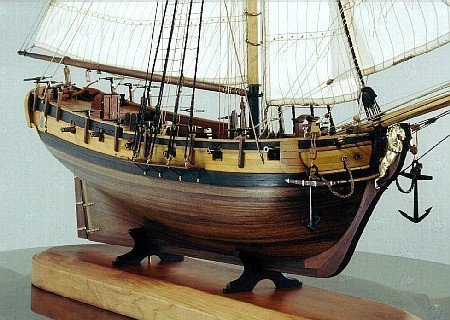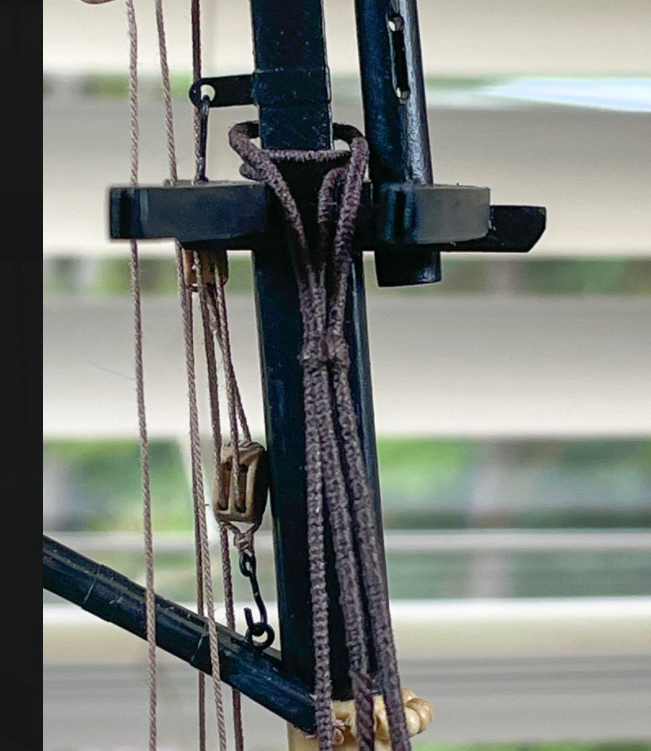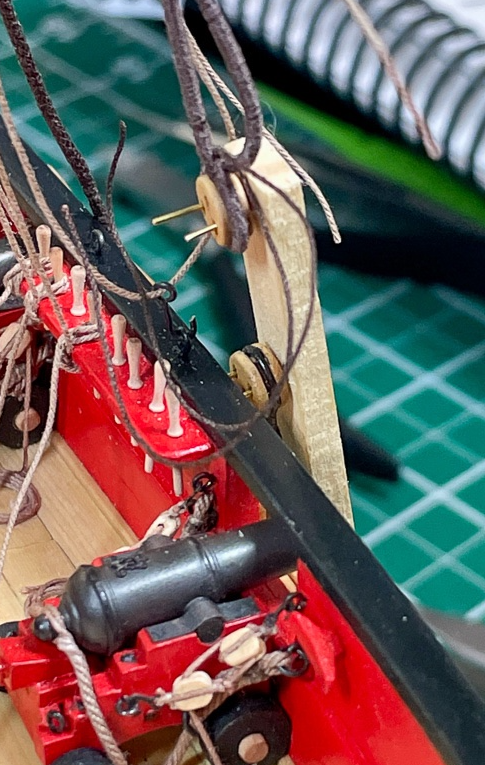-
Posts
3,168 -
Joined
-
Last visited
Content Type
Profiles
Forums
Gallery
Events
Everything posted by Gregory
-
You say CNC.. Is this a laser?
-
when to rig the shrouds to the deadeyes.
Gregory replied to bobc622's topic in Masting, rigging and sails
Not all of it, of course. and it would vary depending on the rig. I was thinking more about the cutter rig with the boom and gaff.. There are several lines that are easier set up but not tied off, before setting up all the standing rigging.. On a two or three mast ship it gets more complicated.. -
when to rig the shrouds to the deadeyes.
Gregory replied to bobc622's topic in Masting, rigging and sails
Something I learned from you and Chuck is to set up as much of the running rigging as you can ( up to a point without tying off ) before permanently setting up the shrouds and stays. -
when to rig the shrouds to the deadeyes.
Gregory replied to bobc622's topic in Masting, rigging and sails
I have heard once or twice about rigging the deadeyes before setting the shrouds, but I don't think I have seen it demonstrated. If it works for you, perhaps you could share your method. The shrouds are seized in pairs, alternating port and starboard, so if you have already attached them to the deadeyes you would have to allow for some slack to be taken up. The shrouds are not actually attached to the mast. Actual practice is done in a certain way for reasons that work. For the most part actual practice works best on the model. Lay the shrouds then set the deadeyes with a lanyard. Using a spacer to set the lanyards may be helpful. It is easier to attain equal spacing on a full size rig without a spacer than it is on a model.. I borrowed some images from Glenn Barlow's Cheerful for good examples.. When you ask for help, the best we can do is show you how it is usually done. When you choose to use a different method, it is harder to provide guidance after the fact. -
I would be interested in seeing any kit that showed the main stay collar with the detail of your drawing from Lees. The closest you will come is in some of the scratch build logs. Chuck' s Cheerful monograph and build log show very detailed rigging steps that could be used for a full rigged ship, but would be missing some of the elements like the main stay collar. Here are the instructions in the Model Shipways USS Constitution for a yard sling. There are no instructions for making the sling other than the image. This post in the Cheerful log has detailed images as well as precise instructions such as:
-
Replying to posts
Gregory replied to Neill's topic in Using the MSW forum - **NO MODELING CONTENT IN THIS SUB-FORUM**
It looks like you managed to reply in that topic.. What did you do to fix it? -
Its not to late to put the Soleil Royale on the shelf and build a couple of simpler kits just to get a feel for the craft..
-
Replying to posts
Gregory replied to Neill's topic in Using the MSW forum - **NO MODELING CONTENT IN THIS SUB-FORUM**
Do you make sure you are signed in? -
I've bought several kits on eBay and pretty much got what i expected for what I paid. I once bought a kit from someone who was up front about not knowing what should be in the kit. Once I received it, it turned out to be severely lacking in some respects. I contacted the seller, and they took my word for the depreciated value and gave me a partial refund with no argument.
-
Idea : Printing fabric sails using heat transfer paper
Gregory replied to modeller_masa's topic in Masting, rigging and sails
While I share the concern with the fading of printer inks, on the other hand, if they fade over the years, the effect may not be all that undesirable in the context of an antique model ship.. -
Idea : Printing fabric sails using heat transfer paper
Gregory replied to modeller_masa's topic in Masting, rigging and sails
The OP has the necessary tools to do the iron on transfers. You suggested a different method that required different tools and a different skill set.. I was just curious as to what would be the advantage in adapting your method. -
Idea : Printing fabric sails using heat transfer paper
Gregory replied to modeller_masa's topic in Masting, rigging and sails
Do the math!😁 -
Idea : Printing fabric sails using heat transfer paper
Gregory replied to modeller_masa's topic in Masting, rigging and sails
Allan, I can't be sure what the thread count is/was, but as I said, I gave gone to a ' thrift shop' and found a shirt or blouse that was made of very fine material where the weave was very difficult to discern. I'll try to find a scrap and see if it is as fine as my memory thinks it is. It may well have been 750 or less.. It may have been silk. I got past the "expensive" part by shopping at Goodwill, etc.. As fine as the material is, the look will not hold up at most popular scales, with any sewing, as you and others have pointed out. I am not much for making sails due to many of the concerns voiced by yourself and others.. I am of the opinion that " if you must do it, try this or this and do the best you can ".. I think the OP has come up with a good idea that I will have to try myself. -
I realize this wont work all the way to the rabbet, but a good start is to follow the contour of the deck..
- 345 replies
-
- Duchess Of Kingston
- Vanguard Models
-
(and 1 more)
Tagged with:
-
Idea : Printing fabric sails using heat transfer paper
Gregory replied to modeller_masa's topic in Masting, rigging and sails
I think the longevity may depend on the ink rather than the medium.. If you have photo quality ink that has UV protection, it should last as long as a good quality color photo. You might also add a light coat of something like Scotchguard or other UV blocker.. -
Idea : Printing fabric sails using heat transfer paper
Gregory replied to modeller_masa's topic in Masting, rigging and sails
What would be the advantage of your method over the iron on transfer? The OP wants these features: I have used the iron on transfer for other projects and the final result is a very fine film. The details are only limited by the original artwork and the resolution of the printer.. -
Idea : Printing fabric sails using heat transfer paper
Gregory replied to modeller_masa's topic in Masting, rigging and sails
I think modeller_masa has come up with a great idea to have sails that resemble the box art without using the form sails provided in the kit. I would suggest the importance of real looking, scale appropriate sails may not be a realistic or desirable goal in this case. What kind of printer would you need for printing on a non-rigid material like silkspan? I have printed on tissue paper by taping it to card stock, but it still has a tendency to gather and tear if it is not perfectly flat. Do they have clothing re-sale shops in the EU? I have found some very fine, high thread count materials in fine men's shirt or women's dresses in these stores. A lot of possible sail material at a very low cost. -
Idea : Printing fabric sails using heat transfer paper
Gregory replied to modeller_masa's topic in Masting, rigging and sails
Great idea. I would look for very fine cloth for the base..
About us
Modelshipworld - Advancing Ship Modeling through Research
SSL Secured
Your security is important for us so this Website is SSL-Secured
NRG Mailing Address
Nautical Research Guild
237 South Lincoln Street
Westmont IL, 60559-1917
Model Ship World ® and the MSW logo are Registered Trademarks, and belong to the Nautical Research Guild (United States Patent and Trademark Office: No. 6,929,264 & No. 6,929,274, registered Dec. 20, 2022)
Helpful Links
About the NRG
If you enjoy building ship models that are historically accurate as well as beautiful, then The Nautical Research Guild (NRG) is just right for you.
The Guild is a non-profit educational organization whose mission is to “Advance Ship Modeling Through Research”. We provide support to our members in their efforts to raise the quality of their model ships.
The Nautical Research Guild has published our world-renowned quarterly magazine, The Nautical Research Journal, since 1955. The pages of the Journal are full of articles by accomplished ship modelers who show you how they create those exquisite details on their models, and by maritime historians who show you the correct details to build. The Journal is available in both print and digital editions. Go to the NRG web site (www.thenrg.org) to download a complimentary digital copy of the Journal. The NRG also publishes plan sets, books and compilations of back issues of the Journal and the former Ships in Scale and Model Ship Builder magazines.






